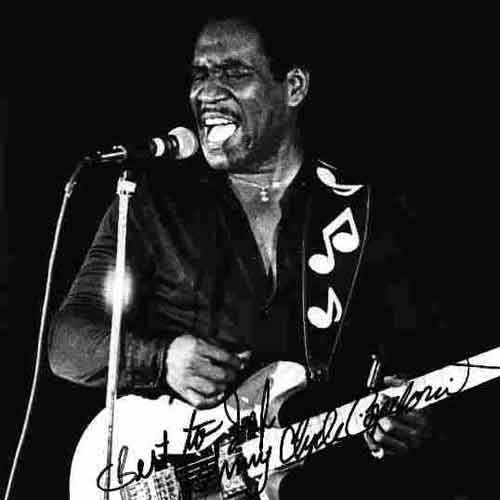
Johnny Copeland
by Richard Skelly & Bruce EderConsidering the amount of time he spent steadily rolling from gig to gig, Johnny Clyde Copelands rise to prominence in the blues world in the early 90s wasnt all that surprising. A contract with the PolyGram/Verve label put his 90s recordings into the hands of thousands of blues lovers around the world. Its not that Copelands talent changed all that much since he recorded for Rounder Records in the 1980s; its just that major companies began to see the potential of great, hardworking blues musicians like Copeland. Unfortunately, Copeland was forced to slow down in 1995-96 by heart-related complications, yet he continued to perform shows until his death in July of 1997. Johnny Copeland was born March 27, 1937, in Haynesville, LA, about 15 miles south of Magnolia, AR (formerly Texarkana, a hotbed of blues activity in the 1920s and 30s). The son of sharecroppers, his father died when he was very young, but Copeland was given his fathers guitar. His first gig was with his friend Joe Guitar Hughes. Soon after, Hughes took sick for a week and the young Copeland discovered he could be a front man and deliver vocals as well as anyone else around Houston at that time.His music, by his own reasoning, fell somewhere between the funky R&B of New Orleans and the swing and jump blues of Kansas City. After his family (sans his father) moved to Houston, Copeland was exposed, as a teen, to musicians from both cities. While he was becoming interested in music, he also pursued boxing, mostly as an avocation, and it is from his days as a boxer that he got his nickname Clyde.Copeland and Hughes fell under the spell of T-Bone Walker, whom Copeland first saw perform when he was 13 years old. As a teenager he played at locales such as Shadys Playhouse — Houstons leading blues club, host to most of the citys best bluesmen during the 1950s — and the Eldorado Ballroom. Copeland and Hughes subsequently formed The Dukes of Rhythm, which became the house band at the Shadys Playhouse. After that, he spent time playing on tour with Albert Collins (himself a fellow T-Bone Walker devotee) during the 1950s, and also played on stage with Sonny Boy Williamson II, Big Mama Thornton, and Freddie King. He began recording in 1958 with Rock n Roll Lily for Mercury, and moved between various labels during the 1960s, including All Boy and Golden Eagle in Houston, where he had regional successes with Please Let Me Know and Down on Bending Knees, and later for Wand and Atlantic in New York. In 1965, he displayed a surprising prescience in terms of the pop market by cutting a version of Bob Dylans Blowin in the Wind for Wand.After touring around the Texas triangle of Louisiana, Texas and Arkansas, he relocated to New York City in 1974, at the height of the disco boom. It seems moving to New York City was the best career move Copeland ever made, for he had easy access to clubs in Washington, D.C., New York, Philadelphia, New Jersey, and Boston, all of which still had a place for blues musicians like him. Meanwhile, back in Houston, the club scene was hurting, owing partly to the oil-related recession of the mid-70s. Copeland took a day job at a Brew n Burger restaurant in New York and played his blues at night, finding receptive audiences at clubs in Harlem and Greenwich Village.Copeland recorded seven albums for Rounder Records, beginning in 1981 and including Copeland Special, Make My Home Where I Hang My Hat, Texas Twister, Bringing It All Back Home, When the Rain Starts a Fallin, Aint Nothing But a Party (live, nominated for a Grammy) and Boom Boom; he also won a Grammy award in 1986 for his efforts on an Alligator album, Showdown! with Robert Cray and the late Albert Collins. Although Copeland had a booming, shouting voice and was a powerful guitarist and live performer, what most people dont realize is just how clever a songwriter he was. His latter-day releases for the PolyGram/Verve/Gitanes label, including Flyin High (1992) and Catch Up with the Blues, provide ample evidence of this on Lifes Rainbow (Nature Song) (from the latter album) and Circumstances (from the former album).Because Copeland was only six months old when his parents split up and he only saw his father a few times before he passed away, Copeland never realized he had inherited a congenital heart defect from his father. He disovered this in the midst of another typically hectic tour in late 1994, when he had to go into the hospital in Colorado. After he was diagnosed with heart disease, he spent the next few years in and out of hospitals, undertaking a number of costly heart surgeries. Early in 1997, he was waiting for a heart transplant at Columbia Presbyterian Medical Center in New York City. As he was waiting, he was put on the L-VAD, a recent innovation for patients suffering from congenital heart defects. In 1995, Copeland appeared on CNN and ABC-TVs Good Morning America, wearing his L-VAD, offering the invention valuable publicity.Despite his health problems, Copeland continued to perform and his always spirited concerts did not diminished all that much. After living 20 months on the L-VAD — the longest anyone had lived on the device — he received a heart transplant on January 1, 1997 and for a few months, the heart worked fine and he continued to tour. However, the heart developed a defective valve, necessitating heart surgery in the summer. Copeland died of complications during heart surgery on July 3, 1997.
